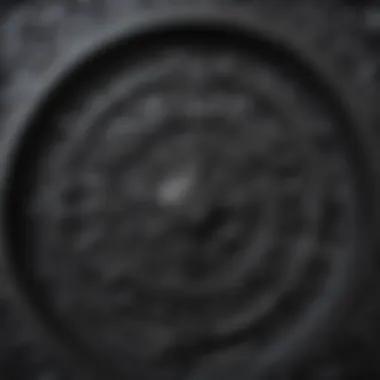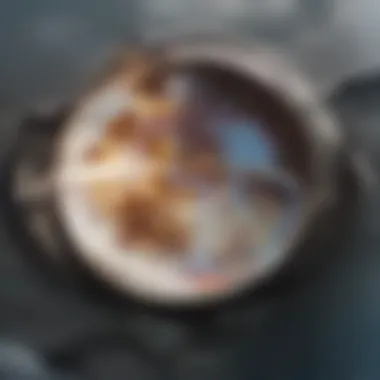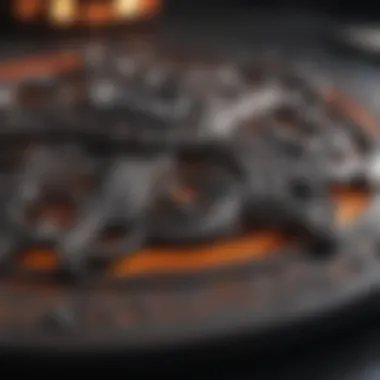Coating Cast Iron: Process, Benefits, and Care


Intro
Coating cast iron cookware holds significant importance for both functionality and aesthetics. This process can transform ordinary cast iron into a durable piece of kitchenware that enhances the cooking experience. Understanding how coating affects cast iron and what materials to use can provide valuable insights, especially for those who take pride in their culinary tools.
Cast iron is lauded for its excellent heat retention and even cooking surface. However, uncoated cast iron may face challenges such as rust formation and food sticking. Thus, coating cast iron serves as a protective layer and improves its usability in the kitchen.
This article will cover various aspects of cast iron coating, including the benefits, methods, and maintenance practices. Homeowners, designers, and cooking enthusiasts can benefit from this knowledge to maximize the performance and aesthetic appeal of their cookware.
Here are the crucial topics that we will discuss:
- The advantages of coating cast iron, including improved longevity and resistance to corrosion.
- Different types of coating materials available, such as enamel and non-stick coatings, alongside their respective benefits and drawbacks.
- The coating process detailing the preparation, application, and curing steps involved.
- Maintenance practices to ensure the long lifespan of coated cast iron cookware.
By synthesizing this information, the article aims to provide a comprehensive understanding of the coating process and its relevance, ensuring that readers can make informed decisions about their cast iron cookware.
Prelude to Cast Iron Coating
The coating of cast iron is an important area of discussion for those who appreciate quality cookware. Understanding this process provides insights into the benefits it offers, as well as considerations that must be taken into account. Coating not only extends the lifespan of cast iron cookware but also enhances its usability and aesthetic appeal. This section introduces the topic and sets the stage for a deeper exploration into the specifics of casts iron and their coatings.
What is Cast Iron?
Cast iron is a versatile material, made by melting iron and pouring it into molds. It is known for its excellent heat retention and even heat distribution, making it a popular choice among cooking enthusiasts. Cast iron skillets and pots are capable of reaching high temperatures, which is ideal for various cooking methods like searing, frying, and baking. Additionally, cast iron cookware is valued for its durability; with proper care, it can last for generations. Beyond practical advantages, cast iron also carries a sense of heritage, often becoming a family heirloom passed down through generations.
Why Coat Cast Iron?
Coating cast iron provides several benefits. First and foremost, coated surfaces offer a level of protection against rust and corrosion, which is especially crucial for cast iron that is typically porous. A well-coated pan is also more non-stick, helping to reduce the amount of oil needed in cooking and facilitating easier food release. This means that cleaning up after cooking becomes much more manageable as food particles do not adhere tightly to the surface.
In addition to practical benefits, coatings can enhance the visual aesthetics of cast iron cookware. Options like enamel can provide vibrant colors and glossy finishes that elevate the cookware's appearance, making it suitable for serving food directly at the table.
Furthermore, the coatings can also improve thermal efficiency. For example, non-stick coatings allow for lower cooking temperatures without compromising the quality of the meal being prepared. Thus, understanding the importance of coating cast iron is vital for anyone looking to maximize the potential of their kitchen tools.
Types of Coatings for Cast Iron
The choices available for coating cast iron are significant for both performance and functionality. Different types of coatings serve varied purposes, enhancing the cooking experience as well as the longevity of the cookware. Understanding what each type brings to the table is essential in making informed decisions. It is important to consider not only the specific applications of these coatings but also how they meet the user’s needs in terms of maintenance and durability.
Enamel Coating
Enamel coating is one of the most popular finishes for cast iron. This type of coating involves fusing powdered glass to the metal surface, which results in a smooth, glossy finish. This coating comes in various colors, providing aesthetic advantages that appeal to both cooks and collectors alike.
Benefits of Enamel Coating:
- Corrosion Resistance: Enamel helps prevent rust and damage from acidic foods, making it suitable for different cooking methods.
- Ease of Cleaning: The smooth surface allows for easy washing, reducing the effort required for maintenance.
- No Seasoning Required: Unlike traditional cast iron, enamel-coated pieces do not require regular seasoning, which simplifies care.
This type of coating does have limitations. Although durable, enamel can chip if handled roughly. Care should be taken in order to ensure a long life for enamel-coated cookware.
Non-stick Coating
Non-stick coatings are designed primarily to prevent foods from sticking during cooking, facilitating easier meal preparation and cleanup. Commonly made from polytetrafluoroethylene, or PTFE, these coatings offer functionality at the expense of some durability compared to other finishes.
Advantages of Non-stick Coating:
- Low-fat Cooking: The non-stick surface allows for cooking with less oil, promoting healthier meals.
- Quick and Easy Cleanup: Food residue tends to slide off with minimal effort, saving time after cooking.
- Versatile Use: Suitable for various cooking techniques, including frying and sautéing.
However, this coating must be used with caution. High heat can damage non-stick surfaces, and metal utensils may scratch them, reducing their lifespan. Knowing how to use and maintain these surfaces effectively is essential for long-term satisfaction.
Natural Seasoning
Natural seasoning refers to the gradual buildup of a non-stick layer on cast iron cookware through oil application and heating. This method develops a natural patina over time, enhancing the cookware's non-stick properties.


Key Points about Natural Seasoning:
- Chemical-Free: This process does not involve synthetic chemicals, which appeals to many health-conscious cooks.
- Customizable: Each user can determine the seasoning level based on cooking habits.
- Durability: Properly seasoned cookware can last for generations when maintained correctly.
Despite these benefits, natural seasoning requires ongoing care. Users must understand how to season their cookware correctly and deal with the occasional re-seasoning based on usage. It demands a commitment from the user but can yield rewarding results.
Coating cast iron is a blend of functionality and art. Each type of coating offers different benefits, influencing both the cooking quality and the care needed.
In summary, the type of coating chosen has a direct effect on the user experience. Whether the preference lies in the visual appeal of enamel, the convenience of non-stick, or the traditional approach of natural seasoning, understanding these options is crucial in selecting the right cookware.
The Coating Process Explained
The coating process for cast iron is essential not only for enhancing the cookware’s longevity but also for improving its functionality and aesthetic quality. This section provides a clear understanding of the crucial steps involved in this process, underpinning why each phase is significant. Proper coating transforms raw cast iron into a versatile culinary tool, offering protection against rust and wear while also allowing for easier cleaning and maintenance.
Preparation of Cast Iron
Preparing cast iron for coating is a foundational step that impacts the adherence and effectiveness of the coating applied later. Initially, any rust or residue must be removed. This can be done using a wire brush or abrasive pads. A thorough cleaning with soap and water is also crucial. After this, it is important to dry the cast iron completely to prevent moisture from getting trapped under the coating.
Once clean and dry, the surface of the cast iron may benefit from light sanding or scouring. This creates a better bonding surface for the coating. It is advisable to remove leftover oils and other substances with a suitable solvent, ensuring no contaminants interfere with the adhesion process. The preparation stage is not to be overlooked; improper preparation can lead to peeling or flaking of the coating down the line.
Application Techniques
The application of the coating itself can be executed through several techniques, each possessing its own merits and challenges. The choice of technique can depend on the type of coating material and the desired finish. Some common application methods include:
- Spray Application: Allows for a uniform coating and is effective for reaching intricate surfaces.
- Brushing: Often preferred for thicker coatings; it offers precision and control over where the coating is applied.
- Dipping: This technique is effective for ensuring complete coverage, especially for smaller objects.
Regardless of the technique chosen, it is essential to apply a thin, even layer to avoid excessive buildup which may affect the performance of the cookware. Multiple coats may be necessary, but each should be allowed to cure before the next is applied, ensuring optimal bonding and a smooth finish.
Curing and Finishing
The final phase of the coating process involves curing, an important step that solidifies the bond between the cast iron and the coating material. Curing times will vary based on the type of coating used. For instance, enamel coatings typically require baking in a high-temperature oven to achieve a hard, durable surface.
After the initial curing, a finishing process may be applied where excess coating is removed and the surface polished. This not only improves the visual appeal but also enhances functionality by creating a smooth surface that is less prone to sticking during cooking.
Properly executed curing ensures maximum durability and performance of coated cast iron cookware, allowing it to withstand high heat and resist damage from cooking processes.
Advantages of Coating Cast Iron
Coating cast iron provides significant benefits that enhance both functionality and appearance. This section elucidates the various advantages that coating offers, emphasizing why it is an important consideration for anyone interested in high-quality cookware. Through an understanding of these factors, users can make informed choices that lead to better cooking experiences and more durable products.
Enhanced Durability
One of the primary benefits of coating cast iron is the substantial increase in durability. Coatings can create a protective layer that guards against rusting and corrosion. Cast iron, while naturally sturdy, is susceptible to these issues when exposed to moisture and air. Coatings like enamel or non-stick finishes provide a barrier, minimizing the direct contact of the base material with potential damaging elements. This not only extends the lifespan of cookware but also maintains its structural integrity over time.
The durability achieved through coating also translates into better heat retention and distribution, making coated cast iron cookware ideal for various cooking methods. Furthermore, high-quality coatings resist scratching, chipping, and peeling, ensuring that the surface remains intact even with frequent use.
Improved Aesthetic Appeal
Coated cast iron is visually appealing. Coatings like enamel are available in various colors and finishes, providing options for customization. This characteristic allows consumers to select pieces that align with their kitchen decor or personal style. A well-coated piece of cast iron not only serves its functional purpose but also acts as a decorative element in the kitchen.
The shiny and smooth finish of coated cookware can make it more inviting to use and showcase. It presents a clean and polished appearance that stands out compared to bare cast iron. This visual upgrade can enhance the overall dining experience, as beautifully prepared food in appealing cookware may increase enjoyment during meals.
Easier Maintenance
Maintaining coated cast iron is generally simpler than uncoated alternatives. The coatings provide a non-stick surface that requires less oil when cooking, which not only aids in health aspects but also simplifies cleaning. Each type of coating may have specific cleaning requirements, yet most allow for easy handwashing with non-abrasive sponges and mild detergents.
Moreover, many coated cast iron options are dishwasher safe, which adds to their overall convenience. This feature is particularly appealing for busy individuals or families who value quick cleanup processes after cooking. The resistance to staining, sticking, or rust also means less time spent on maintenance and more time enjoying culinary creations.
In summary, the advantages of coating cast iron are significant. Enhanced durability, improved aesthetic appeal, and easier maintenance are valuable aspects that elevate the overall cooking experience.


Disadvantages of Coating Cast Iron
When considering the coating of cast iron cookware, understanding the disadvantages is crucial. Some users may overlook these aspects, primarily focusing on the benefits. However, acknowledging potential downsides helps in making informed decisions regarding cookware choices and maintenance. Let's dive into the specific disadvantages related to coatings.
Potential for Damage
Coated cast iron can suffer damage over time, which may affect its longevity and performance. One of the primary concerns involves the possibility of chipping. When a coated piece is improperly handled or subjected to extreme thermal shock, cracks can emerge. This not only impacts the cookware's effectiveness but may also lead to the release of harmful substances, especially in cases involving non-stick coatings.
Another factor is the degradation of the coating due to abrasion. Using metal utensils on coated surfaces can scratch or wear off the protective layer, exposing the cast iron underneath. This might necessitate more frequent replacements, which adds to overall costs.
Lastly, exposure to high heat can lead to the breakdown of some coating materials, particularly those that are not heat-resistant. Over time, this can compromise the appearance of the cookware and reduce its effectiveness. Thus, understanding how to care for coated cast iron is essential to avoid these pitfalls.
Cost Implications
While coated cast iron products often come with a higher initial price tag due to their protective features, the long-term cost implications merit consideration. The upfront investment can seem attractive when envisioning enhanced durability and ease of maintenance. However, consumers should weigh this against potential long-term costs associated with repairing or replacing damaged cookware.
The frequency of replacement is a significant consideration. If a coating chips, scratches, or degrades, the necessity to purchase a new piece arises. This is particularly true for those who wish to maintain aesthetic appeal while using their cookware regularly.
Moreover, specialized cleaning products designed to maintain coated surfaces can add to the cost over time. Unlike traditional cast iron, which can often suffice with basic cleaning agents, maintained coatings require careful attention to sustain their appearance and functionality.
In summary, although the benefits of coated cast iron cookware are evident, it is the disadvantages that often get under-emphasized. By understanding the potential for damage and the cost implications, homeowners can make better choices about their kitchen investments.
Maintaining Coated Cast Iron
Maintaining coated cast iron is crucial for ensuring the longevity and effectiveness of cookware. Proper maintenance not only preserves the aesthetic appeal but also enhances the cooking performance of the cookware. Coated surfaces, while generally easier to care for than uncoated ones, still require attention to keep them in optimal condition. Neglecting maintenance can lead to wear or damage, reducing the benefits that coatings provide, such as non-stick properties and resistance to rust.
Cleaning Techniques
Cleaning coated cast iron is a delicate task. It is important to use methods that will not damage the coating. Here are some effective techniques:
- Use Soft Sponges: Always choose soft sponges or cloths for cleaning. Avoid steel wool or abrasive pads as they can scratch the coating.
- Gentle Detergents: Opt for mild dish soap and warm water. This combination effectively removes residual food without harming the coating.
- Avoid Soaking: Do not soak coated cast iron for long periods. Prolonged exposure to water can weaken the coating's integrity.
- Dry Immediately: After washing, dry the cookware immediately with a soft towel. This prevents water spots and rust development.
- Regular Care: Regular cleaning, ideally after each use, helps maintain the surfaces and prevents buildup.
Maintaining a routine cleaning practice protects the coating and ensures performance remains high.
Re-seasoning Coated Surfaces
Re-seasoning coated surfaces is not always necessary, but it can be beneficial for certain types of coatings, specifically those that have little or no inherent non-stick capability. The process fortifies the coating and enhances its durability. Here’s how to effectively re-season:
- Prepare the Surface: Clean the coated cast iron thoroughly using the methods described above.
- Apply Oil: Use a thin layer of high-smoke point oil, like grapeseed or canola oil. Apply evenly over the surface.
- Heat: Place the cookware upside down in an oven preheated to around 375°F (190°C). This allows excess oil to drip off and creates an even seasoning layer.
- Cool Down: After about an hour, turn off the oven and allow the cookware to cool inside. This helps the oil to bond creating a protective layer.
Re-seasoning can help sustain the functional properties of the coating, ensuring that the cookware serves well for many years.
Maintaining coated cast iron correctly does not only enhance its appearance but also significantly extends its life.
By implementing these maintenance strategies, one can enjoy both the aesthetic and functional benefits of coated cast iron cookware while minimizing any potential drawbacks from poor care practices.
Choosing the Right Cast Iron Cookware
Selecting the appropriate cast iron cookware is fundamental for achieving the best cooking results and ensuring longevity of the kitchenware. The subtleties in design, material composition, and production methods can significantly influence both the cooking experience and the durability of the cookware. When making a choice, one must delve into criteria like quality assessment and understanding brand differences, which can play a crucial role in ensuring wise investments in kitchen essentials.
Assessing Quality
The quality of cast iron cookware is paramount for its performance and your cooking outcomes. High-quality cast iron provides even heat distribution, which is key for cooking techniques such as frying, baking, and sautéing. Here are some specific elements to consider when assessing quality:
- Material Purity: Solid cast iron with minimal impurities will perform better. Ensure the cookware is made from 100% cast iron without bonding agents or fillers.
- Construction: Look for cookware that feels heavy and robust in hand. Lighter pieces may indicate inferior quality.
- Surface Integrity: A smooth and well-finished surface is essential. This affects both the aesthetic appeal and the seasoning process.
- Handle Design: Well-designed handles will afford a secure grip during cooking. Look for handles that are either integral or riveted without any wobble.
By taking these points into account, you can ensure that you are investing in cast iron cookware that meets high standards of quality, elevating your culinary endeavors.
Understanding Brand Differences


The cast iron cookware market is diverse, with numerous brands offering a range of products. Understanding these differences can guide your purchasing decision. Consider the following factors when exploring various brands:
- Reputation: Established brands like Lodge and Le Creuset have built a reputation over the years for producing high-quality cast iron. Their track record can assure you of durability and effectiveness.
- Product Range: Different brands may focus on specific types of cookware—such as skillets, Dutch ovens, or specialty pieces. Assess if their offerings meet your needs.
- Pricing: Brand prestige often influences pricing. Higher prices do not always equate to superior quality, so compare features and manufacturing practices as well.
- Warranty and Support: Brands that offer a warranty may indicate confidence in their product’s longevity. This can provide peace of mind in your purchase.
Understanding these brand dynamics not only aids in selecting quality cookware but also enriches your overall experience as a user of cast iron products. Proper evaluation of quality and brand nuances ensures that you make informed decisions.
"Investing in right cast iron cookware is investing in your culinary future. The choices made today shape your cooking experience for years ahead."
By emphasizing quality assessment and discerning brand differences, you equip yourself to choose cast iron cookware that enhances your kitchen and cooking practices.
Environmental Considerations in Coating
Cast iron cookware has long been revered for its durability and heat retention properties. However, the process of coating cast iron is essential not only for enhancing performance but also for addressing environmental concerns. As we become more conscious of our environmental impact, understanding how coating materials and manufacturing processes affect our planet is increasingly significant. In this section, we will delve into the sustainability of materials used in coatings and the overall impact of manufacturing processes.
Sustainability of Materials
Sustainability in materials for coating cast iron is crucial for reducing ecological footprints. Coatings made from eco-friendly materials contribute to less waste and pollution. Common materials like silicone, ceramic, and certain types of enamel are now gaining popularity due to their lower environmental impact. These materials can often be produced using processes that emit fewer harmful substances compared to traditional coatings.
Using sustainable coatings has several benefits:
- Reduced toxicity: Many conventional coatings may contain toxic compounds. Transitioning to safer alternatives minimizes the risk to both health and the environment.
- Longevity of products: Sustainable materials often enhance the lifespan of cookware, reducing the need for frequent replacements. This not only saves money for consumers but also decreases resource consumption overall.
- Recyclability: Some coatings allow cast iron products to be recycled at the end of their useful life, thus promoting a circular economy.
The shift toward sustainability in material choices demonstrates a growing commitment to responsible manufacturing practices. It allows consumers to enjoy their cookware without compromising their values concerning environmental stewardship.
Impact of Manufacturing Processes
The environmental impact of manufacturing processes in coating cast iron is an aspect that deserves attention. These processes can either alleviate or exacerbate ecological issues depending on their nature.
Several factors contribute to this impact, including:
- Energy Consumption: High-energy processes lead to significant carbon emissions. Opting for manufacturers that utilize energy-efficient practices is a step toward reducing the overall footprint of cast iron products.
- Waste Management: Effective waste management systems can minimize the byproducts produced during the coating process. Innovations in recycling and reusing materials can cut down on landfill contributions.
- Water Usage: Coating processes that require large quantities of water can strain local resources. Manufacturers should aim to implement conservation strategies to ensure their operations do not adversely affect surrounding ecosystems.
The environmental impacts associated with coating cast iron are complex but not insurmountable. By supporting manufacturers committed to sustainable practices, consumers can promote positive changes within the industry.
"The choice of materials and manufacturing processes not only affects the quality of the coating but also has significant ramifications for environmental health and sustainability."
In summary, the environmental considerations in coating cast iron encompass both the materials utilized and the manufacturing processes adopted. As the demand for ecologically responsible products grows, understanding these factors becomes essential for consumers who value sustainability in their cookware choices.
Future Trends in Cast Iron Coatings
As technology evolves and consumer demands shift, the coatings applied to cast iron cookware are also undergoing significant changes. Understanding these shifts is critical for anyone involved in the cookware industry or who has a deep appreciation for quality kitchen tools. The trends not only represent advancements in material science but also respond to a growing consciousness about sustainability and health impacts related to cookware materials. Here, we explore how these future trends are expected to shape the landscape of cast iron coatings.
Advancements in Coating Technology
In recent years, advancements in coating technology have dramatically improved the performance and durability of cast iron cookware. The development of ceramic and titanium-based coatings stands out among these innovations. Ceramic coatings, for instance, offer a non-toxic option that is resistant to scratching and high temperatures. This type of coating also provides even heat distribution, minimizing the risk of hot spots that can lead to uneven cooking.
Moreover, new formulations that use less harsh chemicals in the coating process enhance the safety and eco-friendliness of these products. Brands that invest in research and development are effectively catering to increasingly health-conscious consumers who want assurance that their cookware is free from harmful substances.
"The future of cast iron coatings may lean more towards sustainable materials without sacrificing performance."
Consumer Preferences Shifting
As consumers become more educated and discerning, their preferences are shifting towards products that not only perform well but are also eco-friendly. There is a notable interest in sustainable and ethically produced cookware. Many consumers are now demanding transparency regarding the materials used in coatings and are actively seeking brands that prioritize environmental responsibility.
The rising demand for versatile cookware compatible with various heat sources, including induction, is influencing coating designs. Companies are adapting their products to meet these preferences by developing coatings that provide versatility without compromising the heritage appeal of cast iron.
The End
In this article, we examined the fundamental aspects of coating cast iron cookware. The process of application provides not only a protective barrier but also enhances the usability and aesthetic appeal of cast iron products. Understanding this topic is crucial for anyone who values quality in their kitchen.
Summary of Key Points
- Coating Types: Enamel, non-stick, and natural seasoning each serve different purposes and have unique advantages.
- Application Process: Preparation, application, and curing steps are essential for a durable coating.
- Pros and Cons: While coatings increase durability and make maintenance easier, they can also face risk of damage and incur additional costs.
- Maintenance Needs: Regular cleaning and re-seasoning can help maintain the integrity of coated surfaces, ensuring long-term performance.
- Environmental Impact: The sustainability of coating materials and manufacturing processes should also be considered.
Final Thoughts on Coating Cast Iron
Coating cast iron is more than a mere cosmetic enhancement; it plays a significant role in preserving the material’s qualities. For enthusiasts of cooking and quality cookware, understanding the coating process leads to better choices and greater satisfaction. Embracing coated cast iron not only improves cooking outcomes but also contributes to a more enjoyable culinary experience. As trends evolve, it remains vital to stay informed about advancements in coating technology and consumer preferences, ensuring that cast iron cookware retains its relevance in modern kitchens.



